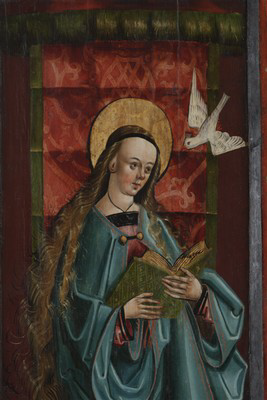Exhibition: Art of the Bohemian Reformation, 1380-1620
 A new exhibition on ‘Art of the Bohemian Reformation, 1380-1620′, curated by our Comenius Postdoctoral Fellow Dr Kateřina Horníčková, will open tomorrow (16 December 2009) at the Imperial Stable of Prague Castle. During the Reformation each of the Christian denominations in the Czech lands used art for representational purposes but, although many of these works survive, those created for non-Catholics have remained little known. The only Protestant church to enjoy legal recognition was the Utraquist; the Unity of Brethren (whose last bishop was Jan Amos Comenius), Lutherans, and Calvinists, did not gain full legal status until 1609. The exhibition, which showcases over 120 works, marks the 400th anniversary of this occasion. It encompasses late-fourteenth-century Hussitism and criticism of the use of images in religious practice, through a blossoming of art under Utraquism and Lutheranism, to the 1619 iconoclasm in St Vitus’s Cathedral, and the final years of the Refomation, which ended with the defeat of Protestant forces at the Battle of White Moutain. Klaudián’s map of Bohemia, the Codex of Jena, the Litoměřice Gradual with its depictions of Jan Hus, a carved altar by the Master IP from the church of the Our Lady upon Tyne, treasures from Kutná Hora, and works by the Rudolphinian artist Bartolomeus Spranger are among the sculptures, altar-pieces, ecclesiastical ornaments, and illuminated manuscripts through which it is possible to trace the radical shift from religious icon as object of veneration to that of image used for didactic, decorative, memorial, and representational purposes. The exhibition runs until 4 April 2010; for full details, see the website.
A new exhibition on ‘Art of the Bohemian Reformation, 1380-1620′, curated by our Comenius Postdoctoral Fellow Dr Kateřina Horníčková, will open tomorrow (16 December 2009) at the Imperial Stable of Prague Castle. During the Reformation each of the Christian denominations in the Czech lands used art for representational purposes but, although many of these works survive, those created for non-Catholics have remained little known. The only Protestant church to enjoy legal recognition was the Utraquist; the Unity of Brethren (whose last bishop was Jan Amos Comenius), Lutherans, and Calvinists, did not gain full legal status until 1609. The exhibition, which showcases over 120 works, marks the 400th anniversary of this occasion. It encompasses late-fourteenth-century Hussitism and criticism of the use of images in religious practice, through a blossoming of art under Utraquism and Lutheranism, to the 1619 iconoclasm in St Vitus’s Cathedral, and the final years of the Refomation, which ended with the defeat of Protestant forces at the Battle of White Moutain. Klaudián’s map of Bohemia, the Codex of Jena, the Litoměřice Gradual with its depictions of Jan Hus, a carved altar by the Master IP from the church of the Our Lady upon Tyne, treasures from Kutná Hora, and works by the Rudolphinian artist Bartolomeus Spranger are among the sculptures, altar-pieces, ecclesiastical ornaments, and illuminated manuscripts through which it is possible to trace the radical shift from religious icon as object of veneration to that of image used for didactic, decorative, memorial, and representational purposes. The exhibition runs until 4 April 2010; for full details, see the website.


 Join
Join 